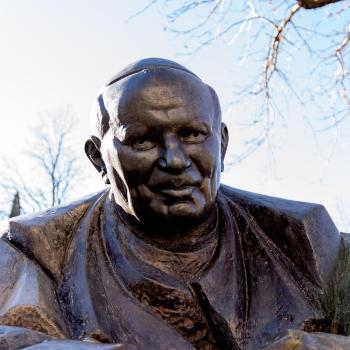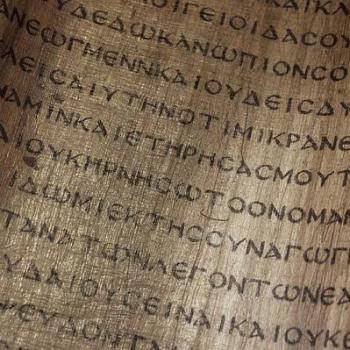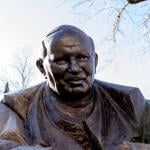THE QUESTION (raised by The New York Times):
What can we know about long-ago biblical figures, for instance Joshua?
How do we know what we know, or think we know, or can know, or might know? “Epistemology” is the branch of philosophy that ponders such matters. It may seem odd, but philosophers even ponder if there’s any basis for believing that anything we remember from before one second ago actually happened!
Back to earth, how do we assess what can be known about people and events from long ago that we ourselves did not witness? One approach is the ideology known as “logical positivism,’ which rules out supernatural claims in advance by definition and thus wipes out many assertions by the great world religions. That’s a simple method, but other philosophers say it’s far too simple.
Well, then, what can we know about the past, whether religious or not? The answer is almost entirely written records that have been passed down to us. This is obviously central with the biblical faiths of Judaism and Christianity, which center heavily upon historical narratives.
Which is why The Religion Guy continues to ponder eight words The New York Times found fit to print in a recent feature about Muslims in Iraq tending what they believe is the tomb of Joshua. Israelis say instead that the ancient patriarch is buried 20 miles north of Jerusalem. Both claimed locations invite skepticism. But the influential newspaper went much further, informing readers:
“There is no historical evidence Joshua actually existed.”
This is not a particularly prudent thing to say in the Muslim world, where Joshua is revered as an actual prophet of God in the line that culminated with the Prophet Muhammad, had no doubt Joshua existed, this according to authoritative hadith texts. Joshua is also referred to in the Quran, though not by name (18:60). The earlier Jewish and Christian Scriptures depict Joshua as an actual person.
In effect, the Times writer and copy editors tell us the Jewish Bible contains nothing that should count as historical evidence. Think about that. Liberal university professors will often teach that a particular Bible section has flawed evidence, or mixes fact with myth, or even is pure fiction. But they do not dismiss all evidence that the Bible records.
There’s good intellectual reason for an open mind on this if we apply the same criteria to non-religious history. In fairness, erasure of the Bible also removes from consideration all ancient writings from across the centuries, meaning we know virtually nothing about Greeks like Alexander, Archimedes, Aristophanes, or Aristotle, or Romans like Caesar, Cicero, Claudius or Cleopatra — or religious figures like Muhammad, Jesus, Zoroaster or Joshua.
Admittedly, we’re on sounder footing with Jesus than Joshua. Thousands of ancient New Testament texts and fragments are available to evaluate, along with some non-biblical mentions. Further, experts’ consensus says the time gap from Jesus’ career to the composition of Gospels we read today was roughly a half-century or so (leaving aside earlier oral or written accounts Gospel writers may have drawn from). That’s like journalists and historians in 2021 researching e.g. the third moon walk, Kent State shootings, Vietnam-era Pentagon Papers, Watergate, or the opening of Disney World — with many eyewitnesses still alive.
(Related aside: As a journalist, The Guy asks himself when radical scholars tell us Jesus didn’t say much of what he said (to quote Yogi Berra): If not Jesus, then who was the genius who was rapidly forgotten yet left behind sayings still discussed 2,000 years later?)
Turning to The New York Times and its disappearing Joshua, let’s briefly unpack what we might know about Moses’ celebrated aide and successor who (purportedly?) led Israel into the Promised Land.
The first reality is that the Israelites were nomads who camped out and did not leave behind palaces with telltale inscriptions in stone that would survive the next 3,000 years, though of course that doesn’t rule out other types of written records such as those in the Hebrew Bible. Archaeologists quip that “the absence of evidence is not evidence of absence.” That is, we cannot assume people did not exist just because no physical remains survived.
We do have one key piece of evidence, however. Though some pooh-pooh this, most specialists say Egypt’s “Merneptah Stele,” dated at 1208 B.C., contains the oldest surviving inscription that mentioned a group living in Canaan named “Israel.” That fixes the context, but archaeological evidence that would corroborate Joshua’s invasion is fiercely debated. See Biblical Archaeology Review‘s coverage on this over the past quarter-century.
Those wanting to thoroughly debunk Jewish Scripture are cheered by “minimalists” like retired University of North Carolina Professor John Van Seters, in works like “In Search of History.”
A less radical consensus view from “higher criticism” is this from the “Anchor Bible Dictionary”: Most references to Joshua in the Bible’s first five books “are secondary insertions and therefore do not reflect historical reality.” The Book of Joshua was written centuries after the events and “utilized a variety of sources of varying historical value.” Etc.
Countering that is fuller authenticity proposed by University of Liverpool Egyptologist K. A. Kitchen in his more recent “On the Reliability of the Old Testament.” He explores what we have from archaeology, but necessarily much of the argument is circumstantial from what’s known about the culture of the times that corroborates the Bible.
His central contention is that skeptical scholars distort what the Jewish Scriptures are saying. First, as throughout the ancient Mideast, there’s hyperbole in the battle accounts. Second he addresses the contention that the so-called “conquest” narratives are simply not plausible. Kitchen says the skeptics mislead us by falsely claiming the Bible depicts “a sweeping conquest and occupation, all in five years or less.” (Many conservative Bible-believers think the same.)
Instead, when read carefully, he says, the Bible tells us Joshua’s flock mostly camped out at Gilgal, conducted a series of raids, and thus laid the foundation for a lengthy process of infiltration and assimilation for which there’s some archaeological evidence. One telltale clue: absence of pig bones. On this, he contends, “the texts are perfectly clear” and perfectly plausible.












